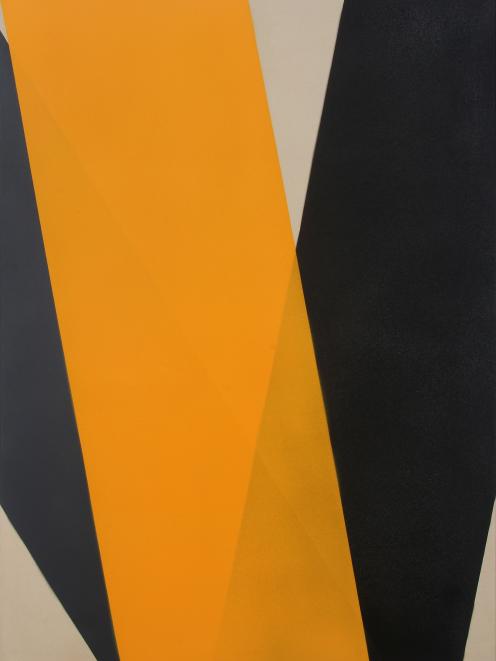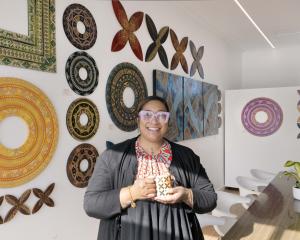Hastings
artist Leanne Morrison is excited about having her first solo show in Dunedin. She tells Rebecca Fox about her transition from hospitality to art.Everything Leanne Morrison owns is covered in paint.
Not surprising really for a painter whose tool is not a brush but a spray gun.
''It's hugely messy. I'm covered up, with a mask on, but there is paint everywhere.''

Giving up a successful career in your 40s to become an artist is a major decision for anyone and for Morrison it was no different.
''I had great jobs but I wasn't really satisfied. I wanted more. At that stage in my life we had not had the opportunity to have children.
''Another one of the life moments and I quietly thought to myself, 'I've got more in me, I want to give more back'.''
She talked to her husband, who had himself had a career change, giving up hospitality to retrain as a psychologist. She supported him through that.

''My husband was incredibly supportive. While I had been thinking of it, it came a bit out of the blue for him.''
It was scary and she was aware she should have done it earlier, but ''I just didn't have the guts to do it''.
''Then I took the plunge, left my job and enrolled in the local technical college.''
Morrison started out with a diploma in art and design at the Eastern Institute of Technology (EIT) but it did not take long for her to realise what she really wanted to do.
''Everything I had been through, all that life experience, being overseas made sense to me to be an artist. I just had to figure out what kind of artist to be.''
So the next step was a bachelor's degree in art and design and by her second year she knew she wanted to continue on to do her master's.
''I put my head down - yep, this is as serious as it gets. I want to have a long career as an artist.''
There were wobbles along the way as she wondered if she was any good, if people would like her work.
''I was putting my heart and soul into this - I'm the hardest on myself.''
She discovered Whitecliff College of Arts and Design in Auckland and her graduate painting installation got her into its master's programme.
''From that point I knew exactly what I wanted to achieve. I'd figured out what type of artist I wanted to be by the end of EIT.''

She was fascinated by the object of painting, the canvas, structure and preparation.
Her mark making came out of her Samoan background where marks are symbols.
''I was painting, mark making on raw canvas with sticks connecting floor, ceiling work in this installation.''
Her technique and process for creating her modernist works developed during the course which she saw as an opportunity to ''really unpack'' her practice - ''the why and how''.
Back then, she had a little studio at the Waiohiki Creative Arts Village, in Napier, and was working with spray cans.
''I was moving away from that physical contact with the surface of the canvas.''
Morrison had concerns about the toxicity of the spray cans she was using and it also created more fine overspray than she wanted.
Someone suggested she borrow their air compressor and she has never looked back.
''It's still an intimate process, carrying out the painting, even though there is very little actual touch between the canvas myself as it's all done at a distance.''
She paints horizontally, creating fine soft layers of paint which she builds up to create an illusion of depth on the surface. Frog tape is used to make the sharp lines defining the blocks of colour and plastic sheets cover the areas she does not want to paint.
''I try and push and pull the paint on the canvas to create texture and layers of opacity and transparency.''

Up to four layers of paint are sprayed but she is never sure what it will look like when she takes the frog tape and plastic off the canvas.
''With spraying, it is never perfect. There are always small imperfections.''
''Process is everything to me . I don't expect to ever not learn, something new always happens.''
There are always variables created by the environment - the temperature of the studio, the viscosity of the paint affects the weight and depth of it.
''It's endlessly interesting to me.''
Each painting is like a reveal to herself, as well.
''I can never really know how the work is going to turn out until I have finished making decisions and deciding at this point let's take everything off and see where it's at.
''I get quite surprised every painting turns out slightly different, not quite what I expected. For me, that is exciting. It is what drives me in my studio.''
Each work leads on to the next. She decides pretty quickly whether or not she likes the outcome.
''The process of painting is quick. It can take one week or two but I have two or three paintings on the go. It's intense - no-one is allowed in.
''Paint does what paint does. It can surprise me every time, as much as I think I'll know how it'll turn out.''
These days she has moved back home to set up a studio in her garage.
''I wasn't getting enough time. For me, it's about getting enough sustained periods in my studio.''
When she is working on a piece, her day is structured. She heads to the studio about 8.30-9am and stays there until 3pm or 4pm.
''If I'm not painting, I'm drawing or making a model, doing stuff and making stuff that will lead back to my painting practice.
''I'm using clay at the moment - it all feeds back into my painting. Those ideas play out in some of the paintings I've been working on. It's lovely to see it unfold.''
She admits to having a very critical eye when it comes to her own work.
''I edit it before I put it before anyone. If I'm not happy with it, it comes off the stretcher, is rolled up and put in a bin.''
That bin is dedicated to those works and every now and again she picks a work out of the bin and revisits it.
''Those things motivate me and keep me going. It can help me decide what to do next.''
She will look and see if she can push the work further or if it goes back in the bin.
Morrison has found painting fits more naturally with her instinctive, introverted personality.
''I had to be extrovert a lot of my previous career because of the jobs I was doing but you have to try harder, you're always exhausted trying to do a good job.''
She is aware it means she needs to make a concerted effort to leave the studio.
''For me there is this real danger that I'll hunker down in my studio, so I have various strategies, such as working part-time.''
One day a week she works at the Hastings City Art Gallery, which gets her out of her studio and also enables her to talk about art.
''It's really important for me to talk to other artists, people who are interested in art. It's a nice way to be in the world and I have a great group of friends who stick by me, even when I might not see them for weeks on end.''
Looking back, she can see how she has always sucked in knowledge on art and culture.
''I've always been interested in that stuff, when I had the opportunity to do it I put my whole heart and soul into it.''
But her focus when she left school was to get away and travel.
''I was such a dreamer.
''I felt like a square peg. I never felt like I fitted in and needed to explore the world.''
So she got a job, saved up and headed to Europe, where she worked in hospitality.
''I just wanted to experience the world, meet people from other cultures.''
She met her Northern Irish future husband in London and the pair worked in bars there for five years.
When they came home, her husband retrained and got a job in Hawke's Bay.
''It's been fantastic. It was a good experience and got me questioning what I was doing.''
Morrison admits the journey has not been all plain-sailing. Being an adult student had its challenges.
''It was very tough. I think I was so focused on what I wanted to achieve from it.''
Going to a regional college probably helped, as there were people of all ages in her course, all there for their own reasons, she says.
''The first six months was a shock. I just tucked my head down and aim for here and I made my way there.''
By the time she got to Whitecliff she realised age had become irrelevant and it was all about the art, the networking and friendships.
''It was so challenging for me. It really made me think deeply about what I was doing,why I was doing it and what my place in contemporary art is - it turned me inside out.''
Good mentors who encouraged and supported her made the difference.
''I took those opportunities when it came along to learn everything, how to carry out, how to make things. My own interpretation of that began to emerge.''
She grew up in Wellington with a Samoan father and mother of Scottish heritage from Westport and two brothers.
''In hindsight, my dad was always fixing things, making things, build a retaining wall and tinkering and I was always right there with him. Mum is an incredible artist in her own right, I think, as a quilter always doing her own designs.
''It's probably where I get it from. It's been quite startling for all of us.''
The hard work paid off as she was awarded the top visual artist of her class at EIT.
''It was encouraging. By that stage, in my mind I knew what I wanted to do.''
Her work at Whitecliff was picked up by Milford Galleries which invited her to exhibit in a group exhibition just after she finished her master's. The work sold.
She did not know then that one of her graduate works would form the basis of her first solo exhibition.
''It wasn't a complete success but it had potential.''
It was rolled up and binned only to be pulled out when she began working on the exhibition.
''It is a slightly new direction for me but I think it works well.''
To get her first solo exhibition was a big step and she was looking forward to seeing all her recent works hanging together in one place.
''I'm quite excited. It's not until they are hung on the wall that they come into their own.''
She is especially keen to see her ''black'' works hung, as they are the last works completed for the exhibition.
''They are the culmination of this extended period of making. I had intended to do only two black paintings but it morphed into four. It's been quite a big job to do but it made sense. They pull together and finish off the show.''
Then she planned to continue with her work and ''see where it takes me''.












